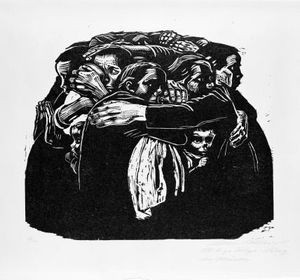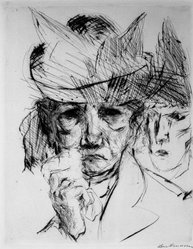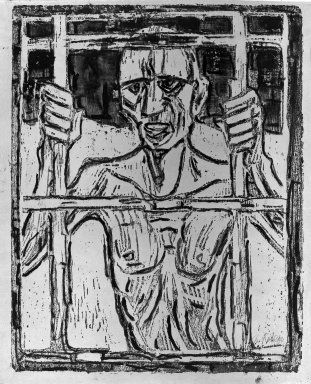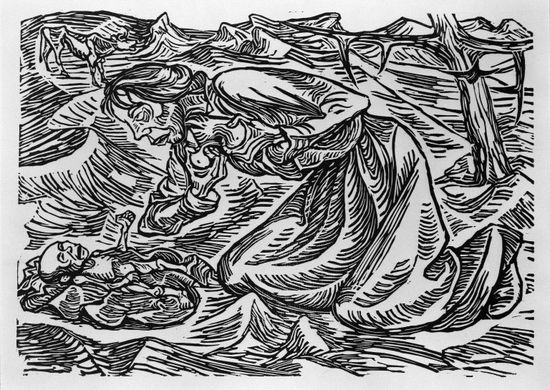German Expressionist Prints at the Brooklyn Museum
The current exhibition in the Herstory Gallery of the Elizabeth A. Sackler Center for Feminist Art features the politically engaged work of early twentieth-century artist Käthe Kollwitz (German, 1867-1945).

Käthe Kollwitz (German, 1867–1945). The Mothers (Die Mütter), 1922–23. Woodcut on heavy Japan paper, 18 13/16 x 25 9/16 in. (47.8 x 64.9 cm). Brooklyn Museum, Carll H. de Silver Fund, 44.201.6. © 2012 Artists Rights Society (ARS), New York/VG Bild-Kunst, Bon
She explored the physical and spiritual dimensions of the human condition primarily through printmaking, a populist medium that resonated with German artists eager to renew the tradition of Northern Renaissance masters such as Albrecht Dürer. The powerful black and white woodcuts and lithographs on view, drawn from two of her major print portfolios, War (Kreig) (1922–23) and Death (Tod) (1934–35), are intensely personal yet universal expressions of devastation, loss, and grief made in response to the horrors of World War I and the early years of National Socialism.
Kollwitz’s works are part of the Brooklyn Museum’s significant collection of prints by artists associated with the German Expressionist and New Objectivity movements, such as Ernst Ludwig Kirchner, Erich Heckel, Emil Nolde, Max Pechstein, Karl Schmidt-Rottluff, Max Beckmann, Otto Dix, Georg Grosz, and many others.

Max Beckmann (German, 1884-1950). Weeping Woman (Weinende Frau), 1914. Drypoint on heavy wove paper, Image: 9 1/4 x 7 5/16 in. (23.5 x 18.6 cm). Brooklyn Museum, By exchange, 38.257. © artist or artist’s estate
The first prints entered the collection in 1937 and were the subject of an exhibition here in 1948, making Brooklyn among the very first major American museums to acquire and present this material (when it was considered contemporary art), a bold move during a period when anti-German sentiment still ran high in the States. The excitement generated by our current presentation of the rarely seen Kollwitz prints seems like a good excuse for a two-part post highlighting some of our other German war-related prints from this era.
Weeping Woman by Max Beckmann (German, 1884-1950) (38.257), who suffered a mental breakdown after serving in the medical corps, depicts a woman bringing a handkerchief to her eyes, which appear black and hollow under a mourning veil. Made in the first year of the war, it is thought to be a portrait of the artist’s mother-in-law who, like Kollwitz, lost her son in battle. Beckmann would immigrate to the United States in 1947 and taught for several years at The Brooklyn Museum Art School (which closed in 1985).

Christian Rohlfs (German, 1849-1939). The Prisoner (Der Gefangene), 1918. Color woodcut in blue and overpainted by the artist, on gray wove paper, Image: 25 x 19 1/2 in. (63.5 x 49.5 cm). Brooklyn Museum, Carll H. de Silver Fund, 65.161
In Christian Rohlfs’ (German, 1849-1939) woodcut The Prisoner (65.161), the rough wood grain texture and heavy lines that articulate the subject’s gaunt face, tense hands, and emaciated body, convey the physical immediacy and force of the artist’s hand. The figure seems to be less a specific POW intern than a despairing manifestation of spiritual and emotional imprisonment in a desolate postwar landscape.

Ernst Barlach (German, 1870-1938). Kneeling Woman with Dying Child (Kniende Frau mit sterbenden Kind), 1919. Woodcut on laid paper, Image: 9 x 12 5/8 in. (22.9 x 32.1 cm). Brooklyn Museum, Gift of Dr. F.H. Hirschland, 55.165.76
Image: overall, 55.165.76_bw_IMLS.jpg. Brooklyn Museum photograph
Ernst Barlach (German, 1870-1938) was a close friend of Kollwitz and shared with her a preoccupation with universal themes of human existence and tragedy. In his nightmarish woodcut Kneeling Woman with Dying Child (55.165.76), a withered woman attempts to breastfeed a starving infant, their angular figures merging with the surrounding spiky and barren landscape. Although it calls to mind a medieval emblem of Famine, Barlach’s image is rooted in the reality of the food shortages that occurred in rural Germany after the war.

Lisa Small joined the Brooklyn Museum in Spring 2011 as Curator of Exhibitions. From 2007 until 2011 she was Curator of Exhibitions at the American Federation of Arts (AFA), coordinating traveling exhibitions such as Turner to Cézanne: Masterpieces from the Davies Collection, National Museum Wales, and Gods and Heroes: Masterpieces from the École des Beaux-Arts, Paris. Prior to joining the AFA, Small was a curator at the Dahesh Museum of Art, where she organized numerous exhibitions, including Napoleon on the Nile: Soldiers, Artists, and the Rediscovery of Egypt and Fantasy & Faith: The Art of Gustave Doré. Small has taught art history at Hunter College and Brooklyn College and has been a member of the art history faculty at the School of Visual Arts since 2008. Small earned a B.A. from Colgate University, an M.A. and an M.Phil in Art History from CUNY, and an M.A. in Arts Administration from NYU.
